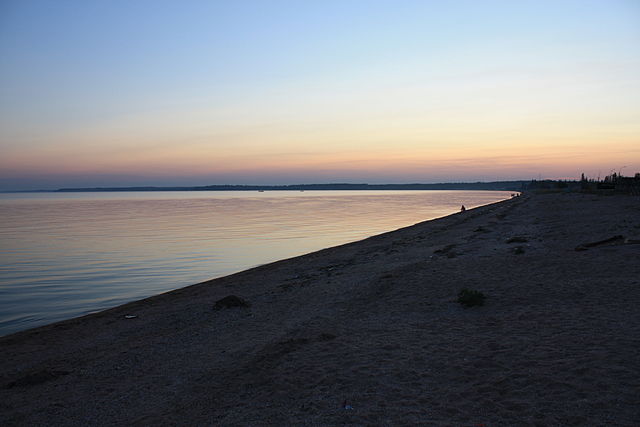The Sea of Azov is an inland shelf sea in Eastern Europe connected to the Black Sea by the narrow Strait of Kerch, and is sometimes regarded as a northern extension of the Black Sea. The sea is bounded by Russia on the east, and by Ukraine on the northwest and southwest, currently under Russian occupation. It is an important access route for Central Asia, from the Caspian Sea via the Volga–Don Canal.
Sea of Azov shoreline at Yalta, Donetsk Oblast
Gravure showing the first attack on Taganrog.
Satellite image of Sea of Azov. The shallow Sea of Azov is clearly distinguished from the deeper Black Sea. Numbers: 1. Dnieper River, 2. Kakhovka Reservoir, 3. Molochna River, 4. Molochnyi Lyman, 5. Arabat Spit, 6. Syvash lagoon system, 7. Karkinit Bay, 8. Kalamitsky Bay, 9. Crimea, 10. Fedosiysky Bay, 11. Strait of Kerch, 12. Black Sea, 13. Sea of Azov, 14. Don River (Russia), 15. Taganrog Bay, 16. Yeysk Liman, 17. Beisug Liman
Major spits of the Sea of Azov: 1. Arabat 2. Fedotov 3. Obitochna 4. Berdyansk 5. Belosaraysk 6. Krivaya 7. Beglitsk 8. Glafirovsk (east) and Yeysk (west) 9. Dolgaya 10. Kamyshevatsk 11. Yasensk 12. Achuevsk 13. Chushka
The Black Sea is a marginal mediterranean sea lying between Europe and Asia, east of the Balkans, south of the East European Plain, west of the Caucasus, and north of Anatolia. It is bounded by Bulgaria, Georgia, Romania, Russia, Turkey, and Ukraine. The Black Sea is supplied by major rivers, principally the Danube, Dnieper and Dniester. Consequently, while six countries have a coastline on the sea, its drainage basin includes parts of 24 countries in Europe.
The estuary of the Veleka in the Black Sea. Longshore drift has deposited sediment along the shoreline which has led to the formation of a spit (Sinemorets, Bulgaria).
Black Sea coast of western Georgia, with the skyline of Batumi on the horizon
Swallow's Nest in Crimea
Coastline of Samsun in Turkey








